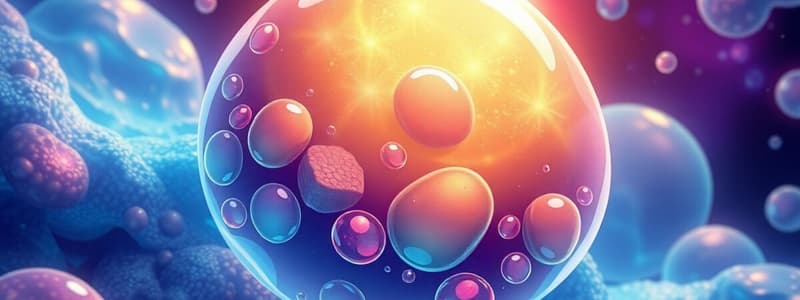Podcast
Questions and Answers
What is the primary role of triglycerides in biological systems?
What is the primary role of triglycerides in biological systems?
- Energy storage (correct)
- Cell signaling
- Structural support
- Water transport
Which characteristic of lipids contributes to their hydrophobic nature?
Which characteristic of lipids contributes to their hydrophobic nature?
- High number of polar functional groups
- Low molecular weight
- Presence of phosphates
- Long hydrocarbon chains (correct)
How do hydrophobic interactions influence lipid organization in aqueous solutions?
How do hydrophobic interactions influence lipid organization in aqueous solutions?
- They enhance the solubility of lipids in water.
- They promote emulsification of lipids.
- They encourage lipids to remain dispersed.
- They drive the aggregation of lipids into droplets. (correct)
Which statement accurately describes fatty acids?
Which statement accurately describes fatty acids?
What outcome occurs due to water's inability to interact strongly with lipids?
What outcome occurs due to water's inability to interact strongly with lipids?
Which carbon in a fatty acid chain is referred to as the ω-carbon?
Which carbon in a fatty acid chain is referred to as the ω-carbon?
What is the consequence of low entropy for dispersed lipids in an aqueous environment?
What is the consequence of low entropy for dispersed lipids in an aqueous environment?
In the context of fatty acids, what does the term 'amphipathic' refer to?
In the context of fatty acids, what does the term 'amphipathic' refer to?
What characterizes saturated fatty acids?
What characterizes saturated fatty acids?
How are fatty acids classified based on the number of carbon atoms?
How are fatty acids classified based on the number of carbon atoms?
What is the significance of the cis configuration in unsaturated fatty acids?
What is the significance of the cis configuration in unsaturated fatty acids?
Why are fatty acids considered highly reduced molecules?
Why are fatty acids considered highly reduced molecules?
What is required for free fatty acids (FFA) to reach target tissues?
What is required for free fatty acids (FFA) to reach target tissues?
What happens to fatty acids in a triglyceride when they are needed for energy?
What happens to fatty acids in a triglyceride when they are needed for energy?
What is the result of esterifying all three hydroxyl groups of glycerol?
What is the result of esterifying all three hydroxyl groups of glycerol?
What distinguishes polyunsaturated fatty acids in terms of double bonds?
What distinguishes polyunsaturated fatty acids in terms of double bonds?
What structural feature characterizes unsaturated fatty acids?
What structural feature characterizes unsaturated fatty acids?
How are fatty acids stored in the body when they are not in use?
How are fatty acids stored in the body when they are not in use?
What occurs during β-oxidation of fatty acids?
What occurs during β-oxidation of fatty acids?
What is the role of the carrier protein albumin in relation to free fatty acids?
What is the role of the carrier protein albumin in relation to free fatty acids?
Why do fatty acids typically form micelles rather than lipid droplets?
Why do fatty acids typically form micelles rather than lipid droplets?
What is a primary characteristic that distinguishes dispersed lipids from aggregated lipids?
What is a primary characteristic that distinguishes dispersed lipids from aggregated lipids?
Which component is not part of the structure of triglycerides?
Which component is not part of the structure of triglycerides?
Which statement correctly describes the nature of fatty acids in the context of their structure?
Which statement correctly describes the nature of fatty acids in the context of their structure?
In aqueous solutions, which of the following interactions primarily drives the aggregation of lipids?
In aqueous solutions, which of the following interactions primarily drives the aggregation of lipids?
How is the carboxylate carbon in a fatty acid chain numbered?
How is the carboxylate carbon in a fatty acid chain numbered?
Flashcards
Lipids
Lipids
A major class of biological macromolecules, characterized by their hydrophobicity and insolubility in water.
Hydrophobic Interactions
Hydrophobic Interactions
The tendency of nonpolar molecules to aggregate together in an aqueous environment, driven by their lack of strong interactions with water.
Macromolecule
Macromolecule
A large, naturally occurring molecule composed of many smaller units linked together.
Amphipathic
Amphipathic
Signup and view all the flashcards
Fatty Acid
Fatty Acid
Signup and view all the flashcards
Triglyceride
Triglyceride
Signup and view all the flashcards
Esterification
Esterification
Signup and view all the flashcards
Solubility
Solubility
Signup and view all the flashcards
Saturated fatty acids
Saturated fatty acids
Signup and view all the flashcards
Unsaturated fatty acids
Unsaturated fatty acids
Signup and view all the flashcards
Cis configuration
Cis configuration
Signup and view all the flashcards
β-oxidation
β-oxidation
Signup and view all the flashcards
Free fatty acids (FFA)
Free fatty acids (FFA)
Signup and view all the flashcards
Albumin (FFA carrier)
Albumin (FFA carrier)
Signup and view all the flashcards
A molecule with three fatty acids esterified to glycerol.
A molecule with three fatty acids esterified to glycerol.
Signup and view all the flashcards
Glycerol
Glycerol
Signup and view all the flashcards
Triacylglycerol (triglyceride)
Triacylglycerol (triglyceride)
Signup and view all the flashcards
Study Notes
Energy Storage Lipids
- Lipids are the fourth major class of biological macromolecules, following proteins, carbohydrates, and nucleic acids.
- Lipids are hydrophobic, meaning they are insoluble in water.
- Lipid molecules have few or no polar functional groups, interacting with water through weak London dispersion forces.
- Their aggregation in aqueous solutions maximizes water entropy, driven by hydrophobic interactions.
- Energy storage lipids aggregate into lipid droplets to minimize the effect on osmolarity.
- Lipids can be used as an energy source for most cells.
- Lipid aggregation pulls lipids out of solution, similar to the precipitation of ionic salts.
- A small amount of lipid remains solvated to maintain the equilibrium constant.
- Lipids separate into a distinct liquid phase, rather than forming a solid.
- This minimizes the effect individual lipid molecules have on osmolarity, allowing cells to maintain osmolarity while storing large energy reserves.
General Properties of Lipids
- Lipids are defined by their hydrophobicity and water insolubility.
- This is due to the limited polar functional groups in these molecules compared to their size.
- Water molecules form a solvation layer around lipids, but water molecules' rotational freedom is restricted.
- This limits water-lipid interaction, favoring lipid aggregation in aqueous solutions.
Fatty Acids
- Fatty acids are carboxylic acids with an aliphatic hydrocarbon group.
- The carboxyl group is hydrophilic, while the hydrocarbon tail is hydrophobic.
- The combined hydrophilic and hydrophobic properties make them amphipathic.
- A typical fatty acid has a 16-carbon chain.
- Carbon numbering in fatty acids starts from the carboxylic acid, with the Greek letter "a" denoting the second carbon (e.g., carbon 2 is the a-carbon).
- The final carbon in a fatty acid chain is called the omega-carbon (ω carbon).
- Fatty acids can vary in the number of carbons and degrees of unsaturation.
- Fatty acids with 7-12 carbon chains are medium-chain fatty acids, and those with 6 or fewer carbons are short-chain fatty acids.
- Most important fatty acids in human metabolism have an even number of carbons.
- Fatty acids can be saturated (no carbon-carbon double bonds) or unsaturated (with at least one).
- Unsaturated fatty acids typically have cis double bonds, creating a kink in the hydrocarbon tail.
- These kinks affect the physical state of fatty acids (e.g., solids or liquids).
- Fatty acids can have multiple double bonds, but these are typically not conjugated (separated by at least one CH2 group).
- Fatty acids are often classified by their w (omega) numbering of the nearest double bond to the end of the fatty acid chain.
Triacylglycerides (Triglycerides)
- Triglycerides are the primary energy storage lipid. This is because they store large amounts of energy per unit volume/mass.
- Fatty acids are esterified to a glycerol backbone to form triacylglycerols (triglycerides).This makes the carboxylate group more hydrophobic, and hence aggregate into lipid droplets.
- Triglycerides are much less polar than fatty acids, making them more hydrophobic and easily stored in lipid droplets.
- Glycerol in triglycerides is prochiral, becoming chiral only when the esterified fatty acids on carbon 1 and 3 differ.
- Triglycerides are stored in adipose tissue (fat tissue).
- When needed, triglycerides are hydrolyzed into free fatty acids (FFAs) and glycerol.
- FFAs are transported in the bloodstream bound to carrier proteins (e.g., albumin), reaching target tissues.
- Intact triglycerides are transported via lipoprotein particles (e.g., chylomicrons, HDL, LDL), which are surface-bound and delivered to the correct tissue.
Studying That Suits You
Use AI to generate personalized quizzes and flashcards to suit your learning preferences.




